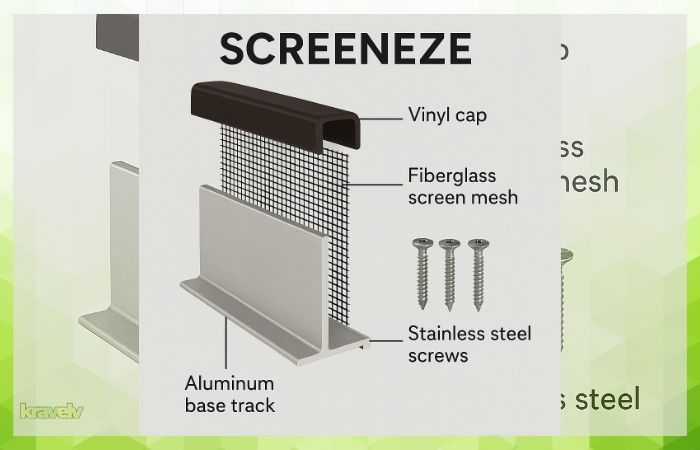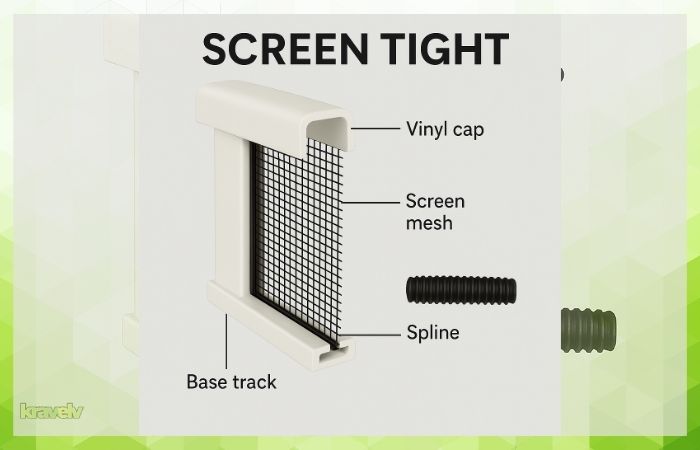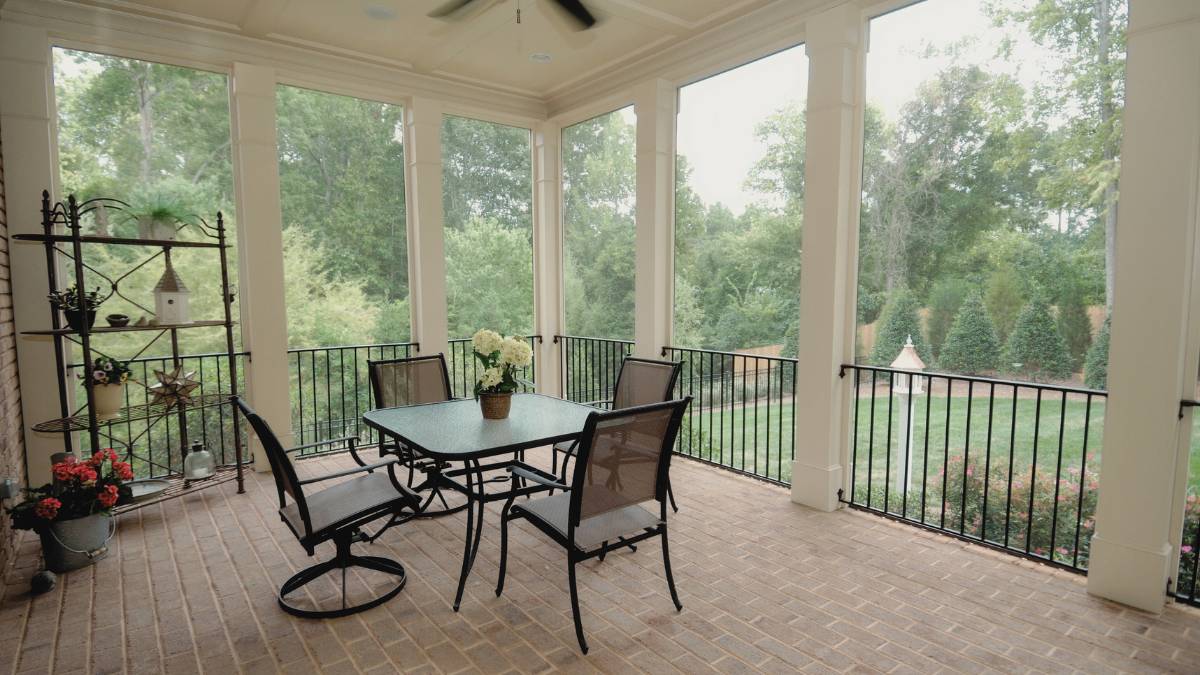Last Updated on April 11, 2025 by Kravelv Spiegel
Screening in a porch or patio can greatly enhance the usability of your outdoor spaces, providing a barrier against insects while allowing fresh air and sunlight to filter through. Two of the most popular screening systems for professionals and DIY enthusiasts alike are Screeneze and Screen Tight. Each system has its unique features, benefits, and installation processes, making it crucial to understand their differences to choose the right one for your project. This article will delve deeply into the specifics of both systems, covering their design, materials, installation procedures, durability, maintenance, and cost-effectiveness.
💡Key takeaways:
- Screeneze uses a combination of aluminum and vinyl for a sleek, durable design, while Screen Tight relies on UV-resistant vinyl for ease of use.
- Screeneze involves snapping a vinyl cap over an aluminum base, while Screen Tight uses a spline to secure the screen mesh.
- Screeneze offers superior durability and minimal maintenance, whereas Screen Tight is budget-friendly and easy to install.
- Screeneze is costlier initially but offers long-term value, while Screen Tight is affordable with readily available replacement parts.
What Are Screeneze and Screen Tight?
Screeneze is a no-spline porch screening system. It uses a base and cap to hold the screen tight without staples or splines. You can build big screen panels without sagging.
Screen Tight is a more traditional system that uses a spline to hold the screen in a plastic track. It’s simple and easy to use, especially for smaller porches.
Screeneze vs Screen Tight In a Glance
| Feature | Screeneze | Screen Tight |
|---|---|---|
| Materials | Aluminum base, vinyl cap | UV-resistant vinyl |
| Design | Sleek, modern | Classic, straightforward |
| Installation | Snap vinyl cap over aluminum base | Use spline roller to secure screen |
| Durability | Highly durable, resistant to warping and cracking | Durable, but less sturdy than aluminum |
| Maintenance | Minimal, occasional cleaning | Minimal, occasional cleaning |
| Cost | Higher initial cost, long-term value | More affordable upfront |
| Colors | White, bronze, clay, sandstone | White, gray, beige, brown |
| Long-Term Value | High due to durability and minimal maintenance | Good, with affordable replacement parts |
Design and Materials
Appearance: What Colors Are Available?
Both systems offer color choices to match your home. Here’s a quick look:
| System | Colors Available |
|---|---|
| Screeneze | White, Bronze, Clay, Sandstone |
| Screen Tight | White, Gray, Beige, Brown |
If you’re looking for a specific color, this table helps make it easy to compare.
Screeneze

Screeneze is a fixed screen system known for its innovative and straightforward design. It comprises an aluminum base and a vinyl cap that securely holds the screen mesh in place. The system is designed to be low-profile and aesthetically pleasing, with a sleek, modern look that can blend seamlessly with various architectural styles.
- Materials: The aluminum base provides durability and structural support, while the vinyl cap adds flexibility and ease of use. The materials are UV-resistant, ensuring longevity even when exposed to direct sunlight.
- Colors: Screeneze offers a range of colors for both the base and cap, including white, bronze, clay, and sandstone, allowing for customization to match the existing decor.
Screen Tight

Screen Tight is a classic screening system that has been popular for decades. It uses a base strip and a cap system made from UV-resistant window-grade vinyl, which holds the screen mesh securely in place. The system is known for its ease of installation and maintenance.
- Materials: Made primarily from high-quality, UV-resistant vinyl, Screen Tight components are durable and can withstand exposure to the elements. The vinyl material also ensures that the system remains rust-free and does not corrode over time.
- Colors: Screen Tight is available in several colors, including white, gray, beige, and brown, allowing for some degree of customization.
Installation Process
Screeneze
Screeneze installation is relatively straightforward but requires precise measurements and cutting. Here’s a step-by-step guide:
- Measure and Cut: Measure the dimensions of the opening to be screened. Cut the aluminum base and vinyl cap to fit these measurements.
- Install the Base: Attach the aluminum base to the frame using screws. Ensure that it is level and securely fastened.
- Screen Attachment: Lay the screen mesh over the opening and position it over the aluminum base.
- Install the Vinyl Cap: Snap the vinyl cap over the screen and aluminum base, securing the screen mesh in place.
- Trim Excess Screen: Use a utility knife to trim any excess screen material for a clean, finished look.
Screen Tight
Screen Tight is known for its user-friendly installation process, making it a favorite among DIY enthusiasts. Here’s how to install it:
- Measure and Cut: Measure the opening and cut the base strips to fit.
- Attach the Base Strips: Secure the vinyl base strips to the frame using screws or staples. Ensure the strips are level.
- Install the Screen Mesh: Lay the screen mesh over the base strips.
- Insert the Spline: Using a spline roller, press the spline into the grooves of the base strip, securing the screen mesh in place.
- Install the Cap: Snap the vinyl cap over the base strip, concealing the spline and providing a neat finish.
- Trim Excess Screen: Trim any excess screen material with a utility knife.
Durability and Maintenance
Screeneze
- Durability: Screeneze’s combination of aluminum and vinyl makes it highly durable. The materials are resistant to warping, cracking, and discoloration, even under harsh weather conditions.
- Maintenance: Maintenance is minimal with Screeneze. Occasionally cleaning the screen and frame with mild soap and water is usually sufficient to keep it in good condition.
Screen Tight
- Durability: Screen Tight’s vinyl components are robust and can endure various environmental conditions. However, vinyl is generally less sturdy than aluminum, which can make Screen Tight slightly less durable in the long term compared to Screeneze.
- Maintenance: Similar to Screeneze, Screen Tight requires minimal maintenance. Regular cleaning with soap and water will help maintain its appearance and functionality.
Wind Resistance: Which One Holds Up Better?
If you live in a windy area or a hurricane zone, this matters.
- Screeneze is tested to handle winds up to 140 mph.
- Screen Tight is less resistant to strong winds, especially with large panels.
Winner: Screeneze for strength.
Cost-Effectiveness
Screeneze
- Initial Cost: Screeneze tends to be more expensive initially due to its high-quality materials and innovative design. However, its durability can make it a cost-effective choice in the long run.
- Long-Term Value: The system’s longevity and minimal maintenance needs contribute to its long-term value, making it a worthwhile investment for many homeowners.
Screen Tight
- Initial Cost: Screen Tight is generally more affordable upfront, making it a popular choice for budget-conscious projects.
- Long-Term Value: While not as durable as Screeneze, Screen Tight still offers good value due to its ease of installation and maintenance. Replacement parts are also readily available and affordable.
Warranty: How Long Are You Covered?
Knowing the warranty helps you feel confident in your investment.
- Screeneze offers a 10-year limited warranty.
- Screen Tight offers a 5-year limited warranty.
Screeneze gives you longer protection, which may matter if you’re spending more.
Which one should you choose?
Here’s a quick summary:
| Feature | Screeneze | Screen Tight |
|---|---|---|
| DIY Friendly | Moderate | Easy |
| Max Panel Size | Up to 150 sq. ft. | Up to 40 sq. ft. |
| Wind Resistance | Up to 140 mph | Moderate |
| Warranty | 10 years | 5 years |
| Color Options | 4 colors | 4 colors |
| Price | Higher | Budget-friendly |
Screeneze vs Screen Tight FAQs
What are the primary materials used in Screeneze and Screen Tight systems?
Screeneze uses aluminum and vinyl, while Screen Tight is made from UV-resistant vinyl.
How does the installation process differ between Screeneze and Screen Tight?
Screeneze involves snapping a vinyl cap over an aluminum base, whereas Screen Tight uses a spline roller to secure the screen mesh in place.
Which system is more durable, Screeneze or Screen Tight?
Screeneze is generally more durable due to its aluminum and vinyl construction, making it more resistant to warping and cracking over time.
Which screening system is more budget-friendly?
Screen Tight is more affordable upfront, making it a popular choice for budget-conscious projects.
Final Words
Choosing between Screeneze and Screen Tight depends on your specific needs, budget, and preferences.
- Screeneze is ideal for those looking for a high-end, durable solution that offers long-term value and a sleek appearance. Its aluminum and vinyl construction ensures longevity, making it a smart investment for those willing to spend a bit more initially.
- Screen Tight is perfect for budget-conscious projects that require a reliable and easy-to-install screening solution. Its vinyl components are durable and low-maintenance, offering good value for money.
Both systems have their strengths, and understanding these can help you make an informed decision for your next screening project. Whether you prioritize durability, aesthetics, ease of installation, or cost, either ScreenEze or Screen Tight can provide a satisfactory solution for screening in your outdoor spaces.

